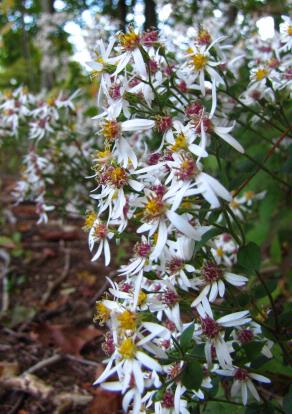My ride to work has become much more beautiful in the last few weeks. The leaves are turning of course, but the show that really grabs me goes on a little lower. The fall flowers are bursting out everywhere I look. Little surprises like the white wood asters (pictured), goldenrod, and chicory fill the fields, old orchards and roadsides. Pokeweed berries hang, tempting the indigent boarders to make poisonous cocktails. The grasses put on a subtler show with light brownish purple. Individually the grass flowers are nothing to look at, but as a mass they undulate in the wind making me think of some Little House on the Prairie idyll, only not as saccharine.

Organisms don’t waste all that energy on me, the flowers serve a purpose. They attract insects to spread pollen and continue the species. The grass flowers don’t attract insects, but they wave in the wind releasing pollen to land on other flowers. They all make seeds and fruit that will either wait out the winter above the snow or rest under its heavy insulating blanket. The parents equip their offspring with what it takes to make it through to spring. Each individual proves its fitness by creating offspring that survive to reproduce.
My fall rituals bear at least passing similarity. I gave the children some food and sent them out the door “live well, make babies.” But they refused. Apparently they’re “too young,” or “scared.” What rot.
That failed so I’m putting up what food I can to help us make it through the winter. I harvested something north of a bushel of sweet potatoes. These will keep in the basement along with the bushel and a half of potatoes. The onions did very well this year, yielding enough that we won’t have to buy onions until spring. My butternut squash fared poorly because of a one-two punch from squash bugs and squirrels, but we probably have enough to eat one a week through January. This year I even have a little hoop house system in the making to grow lettuce, beets and spinach into late fall.
We haven’t even had a freeze yet, but I’m reminded of last year’s October storm and how quickly comfort turns into discomfort when the lights go out. Our livelihood, especially in winter, rests upon cheap transportation and energy. According to the FBI (http://www.fbi.gov/stats-services/publications/law-enforcement-bulletin/february-2012/agroterrorism) most supermarkets stock less than a 7 day supply of food. What’s more, the food tends to be pretty perishable. In New England 100 years ago winter food meant things that stored: squash, beans, some meats, cabbage, potatoes, apples, cider, and beer. The summer was spent preparing by growing food and cutting wood.
Most of us don’t need to prepare for the season, it just gets cold, the heat comes on and we start gaining back our winter weight. Those flowers remind me that it might be healthy to think of this as a season of preparing for the coming dark and cold. Maybe I don’t need to stock up on burnables, but perhaps I should get outside and make some extra vitamin D.


